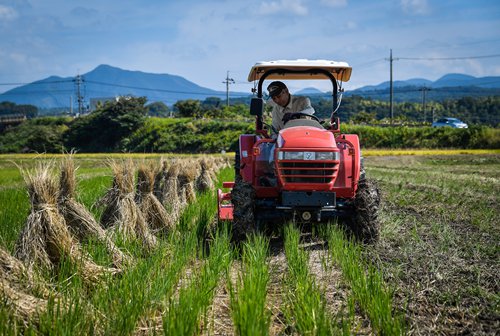
A farmer harvests rice in Tottori Prefecture, Japan in October 2017. Photo: IC
Chinese Premier Li Keqiang and Japanese Prime Minister Shinzo Abe on Wednesday signed an agreement to set up a joint body of experts to discuss the relaxation of an import ban on Japanese agricultural products, according to Japanese media reports.
The ban on products from Fukushima and nine other Japanese prefectures was imposed by China after the 2011 earthquake and nuclear power plant accident in Fukushima, reflecting fear of contamination.
An agreement was also reached on Wednesday to change the rules for rice exports from Japan to China.
Japan has been trying to increase its exports of agricultural products, aiming to reach 1 trillion yen ($9 billion) by 2019. China was the third-largest overseas market for Japanese produce last year at $900 million, according to Japan's Ministry of Agriculture, Forestry and Fisheries.
Japan has been lobbying foreign countries to repeal their bans on the nation's produce. A dispute on this issue with South Korea led to litigation at the WTO, which ruled in favor of Japan on February.
"Japan wants international recognition for agricultural products from Fukushima and its vicinity," Zhang Jifeng, a research fellow with the Institute of Japanese Studies at the Chinese Academy of Social Sciences, said in an interview with the Global Times.
"If the ban is lifted I would buy products from Japan," said a shopper who frequents a Japanese-owned store in Beijing. "I expect that imported products will have passed strict safety requirements on both sides. The Japanese today are consuming their own products and they seem fine," she said.
The agreement also opened the way for more Japanese rice sales to China. Since China first allowed imports of Japanese rice in 2007, all shipments of the grain had to be polished and fumigated at designated facilities in Kanagawa Prefecture, south of capital Tokyo.
The approved polishing facilities have been expanded from one to three, and fumigation facilities from five to seven, distributed across Japan. This change is expected to help sales of Japanese rice to China.
"With more facilities for processing rice, Chinese consumers will have more options to buy rice from different Japanese regions," an official with the Japanese Ministry of Agriculture, who only gave his name as Nozoe, said in an interview with Global Times.
"Having more facilities will also help speed up the process and lower costs, so we will able to provide Japanese rice at a more agreeable price for Chinese buyers," he said.
Rice is the most consumed grain in both China and Japan, but annual per capita consumption in China, at 105 kilograms per year, is about double that of Japan with 54, according to Japanese government data.
Customs data show China imported 4 million tons of rice in 2017, mostly from Southeast Asia. And Japan is trying to expand its presence in China by appealing directly to consumers
"We have now an antenna shop in Shanghai, where you can taste rice from different areas of Japan. E-commerce sites and Japanese restaurants in China also increasingly offer Japanese rice," said Nozoe. But challenges remain.
An antenna shop refers to a physical store run by a government entity with the purpose of market research.
"Sales are constant but not very high," a woman surnamed Zeng, owner of an online shop offering imported food, told the Global Times.
